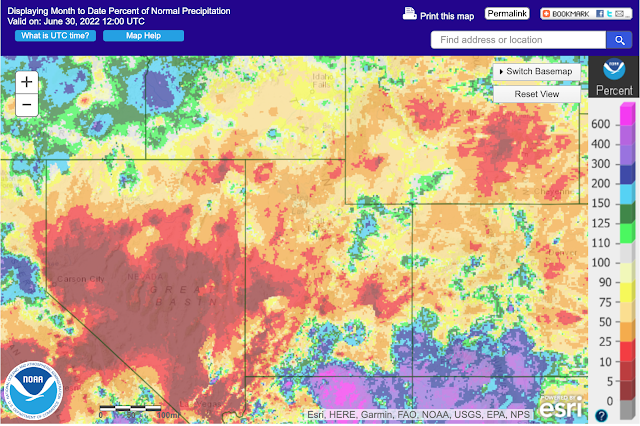Yesterday's high at the Salt Lake City International Airport of 107˚F set a record for the calendar day and tied the the all-time high temperature reached previously on 26 July 1960, 13 July 2002, and 15 June 2021.
Nearly all stations reporting to MesoWest at elevations below 5000 feet elevation in the Salt Lake Valley were at or above 100˚F. Record highs for the calendar day were also set at the City Creek water plant (98˚F), BYU (104˚F), and Tooele (105˚F).
I fielded a number of question yesterday about why the airport is so warm and whether or not the instrument is properly calibrated. We have dealt with such questions many times since I started this blog over 10 years ago (for example, see What's Up @KSLC). Only the National Weather Service can comment on the current calibration of the KSLC instrument. I'll address here the representativeness (or lack thereof) of the airport observing location.
Urban and near-urban areas exhibit large spatial variability in temperature. There is no single representative site at which you can measure temperature in an urban area. Temperatures will be different in Liberty Park than downtown. One side of a building is going to have a different temperature than another. Variations of a few degrees or more are not uncommon.
Airport observations are representative of airports. Airports do not have the same building or surface characteristics as downtown cores, suburban areas, highway corridors, or city parks.
Based on the available observations, it is not unusual for KSLC to observe the highest temperature in the Salt Lake Valley on summer afternoons. This is especially true when the flow is from the south (as it was yesterday) and the lake breeze and up-valley northwesterly flow that often develops during the day is suppressed.
One reason for this is the airport is the lowest place in the valley. Another is that the airport is in an area with limited tree cover and irrigation, especially since the closure of Wingpointe Golf Course.
Additionally, the site of the National Weather Service station is likely vegetation free. It was the last time I visited there and was when the satellite imagery used by MesoWest was collected. Note the observing site below (temperature of 104˚F from yesterday) showing the station in the middle of a denuded field.
 |
| Source: Mesowest |
Trends at the airport have also been affected not only by global and regional climate change, but also urbanization along the Wasatch Front and nearby region, airport development, moves of the observing site, and instrumentation changes. These issues have also come up frequently on this blog. There is no location in the Salt Lake Valley that would not be affected by changes such as these (the airport development might be unique to that location, but everywhere in the Salt Lake Valley has experienced developmental change).
So, an all-time record at the airport is just that. An all-time record based on observations collected by the National Weather Service (or their predecessor the US Weather Bureau) at the airport (or prior to the late 1920s downtown Salt Lake City).
Meanwhile, across the pond, the UK Met Office is still expecting the all-time record high for the UK of 38.7˚C to fall today or tomorrow. I just tried to pull up some observations from the UK Met Office Weather Observations Website and just got a spinning wheel. There must be a lot of meteorologists checking out the latest readings ;-). The UK Met Office has reported that it is likely already the hottest day on record in Wales.

















.png)
.png)








